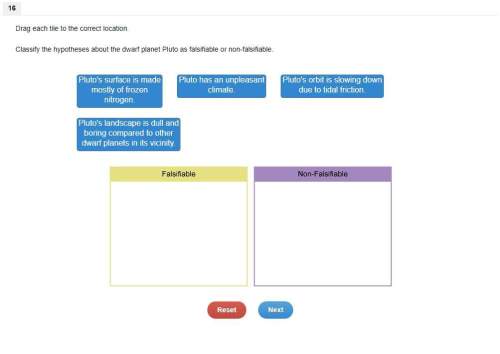
Physics, 25.07.2019 23:00 bobbyxii6033
Atraveling periodic wave passes a point of observation. at this point, the time between successive crests is 0.2s. what can you say about this wave?

Answers: 2


Another question on Physics

Physics, 21.06.2019 21:30
Apendulum has a mass of 1.5 kg and starts at a height of 0.4 m. if it is released from rest, how fast is it going when it reaches the lowest point of its path? acceleration due to gravity is g = 9.8 m/s2. a. 2.8 m/s b. 0 m/s c. 5.9 m/s d. 4.3 m/s
Answers: 1

Physics, 21.06.2019 22:30
Astudent is given an assignment to demonstrate diffraction. he takes a photograph of a straw in a glass of water. the straw appears bent at the water level. which best describes this example? a) this is a good example of diffraction. b) this is an example of dispersion and not diffraction. c) this is an example of refraction and not diffraction. d) this is an example of reflection and not diffraction.
Answers: 1

Physics, 21.06.2019 22:30
Follow these directions and answer the questions. 1. shine a pencil-thin beam of light on a mirror perpendicular to its surface. (if you don't have a laser light as suggested in the video, you can make a narrow beam from a flashlight by making a cone from black construction paper and taping it over the face of the flashlight.) how does the light reflect? how does the relationship of incident to reflected ray relate to the reflection of water waves moving perpendicular to a barrier? 2. shine a pencil-thin beam of light on a mirror standing on a sheet of paper on the table (or floor) so that you can mark the incident ray and reflected ray. (you can support the mirror from the back by taping it to a wooden block.) 3. mark a line on the paper representing the reflective surface. (the reflective surface of a mirror is usually the back edge.) 4. draw a dashed line perpendicular to the mirror surface at a point where the incident and reflected ray meet. this perpendicular is called a normal to the surface. 5. measure the angles between the rays and the normal. the angle of incidence is the angle formed by the incident ray and the normal to the surface. the angle formed by the reflected ray and normal is called the angle of reflection (r). what is the angle of incidence? what is the angle of reflection? 6. repeat for several different angles. (see report sheet for details.) what appears to be the relationship between the angle of incidence and angle of reflection? in science 1204, what was the relationship for these two angles made by the reflection of waves in a ripple tank? 7. roll a ball bearing so that it hits a fixed, hard surface (a metal plate) at several angles (including head-on). observe the way in which the ball bearing reflects. what generalization can you make about how a ball bearing reflects from a wall? have you proved that light can only behave like a wave?
Answers: 1

Physics, 21.06.2019 23:20
In the sport of parasailing, a person is attached to a rope being pulled by a boat while hanging from a parachute-like sail. a rider is towed at a constant speed by a rope that is at an angle of 15 ∘ from horizontal. the tension in the rope is 1900 n. the force of the sail on the rider is 30∘ from horizontal. what is the weight of the rider? express your answer with the appropriate units.
Answers: 1
You know the right answer?
Atraveling periodic wave passes a point of observation. at this point, the time between successive c...
Questions



Advanced Placement (AP), 11.03.2020 12:20

Computers and Technology, 11.03.2020 12:21

Social Studies, 11.03.2020 12:22

Mathematics, 11.03.2020 12:22


Mathematics, 11.03.2020 12:23


Computers and Technology, 11.03.2020 12:24



Mathematics, 11.03.2020 12:28


Physics, 11.03.2020 12:28

Mathematics, 11.03.2020 12:29



Chemistry, 11.03.2020 12:29





